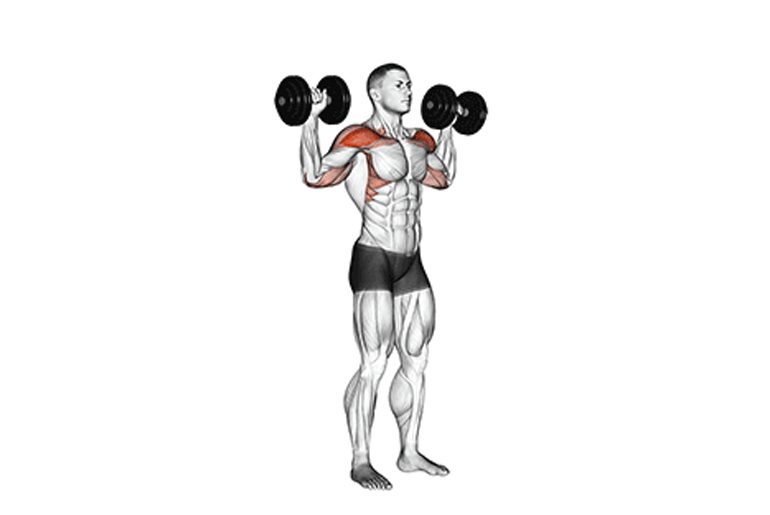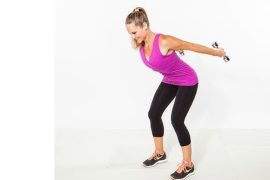Shoulder press exercises are essential for building upper body strength, enhancing shoulder stability, and improving overall muscle definition. These exercises target the deltoids, triceps, and upper chest while also engaging the core for balance and control. Variations include the barbell shoulder press, dumbbell shoulder press, Arnold press, and machine press, each offering unique benefits.
Proper form is crucial to prevent strain and maximize effectiveness—keeping the back straight, engaging the core, and controlling the movement. Regularly incorporating shoulder presses into your workout routine can improve shoulder mobility, enhance athletic performance, and support better posture.
1. Barbell Shoulder Press (Military Press)
- How to do it: Stand with your feet shoulder-width apart, holding a barbell at shoulder height with palms facing forward. Press the barbell upward until your arms are fully extended, then slowly lower it back down to shoulder height.
- Benefits:
Builds shoulder strength and size.
Enhances stability and coordination.
Engages core muscles for balance and posture improvement.
Can be modified to a seated position for those with lower back concerns.
2. Dumbbell Shoulder Press
- How to do it: Sit or stand holding a dumbbell in each hand at shoulder height, palms facing forward. Press the dumbbells upward until your arms are fully extended, then lower them back down.
- Benefits:
Allows a greater range of motion compared to the barbell press.
Improves muscle imbalances since each arm works independently.
Enhances shoulder stability and overall upper body strength.
3. Arnold Press
- How to do it: Hold a dumbbell in each hand with palms facing you, elbows bent. As you press the weights upward, rotate your palms to face forward, completing the motion at the top.
- Benefits:
Targets all three deltoid heads (anterior, lateral, and posterior).
Enhances shoulder mobility.
Improves coordination and stability through rotational movement.
4. Seated Shoulder Press
- How to do it: Sit on a bench with a back support, holding a dumbbell or barbell at shoulder height. Press the weights overhead until arms are extended, then lower them back to the starting position.
- Benefits:
Provides more back support, making it easier on the lower body.
Focuses on the shoulders and arms while reducing the risk of using improper form.
Great for beginners or those with lower back issues.
5. Push Press
- How to do it: Start with the barbell at shoulder height. Slightly bend your knees and use the momentum from your legs to press the barbell overhead.
- Benefits:
Involves the legs, enhancing overall power and strength.
Helps with explosive strength, useful in Olympic lifting and athletic training.
Engages the core for stability and balance.
6. Kettlebell Shoulder Press
- How to do it: Hold a kettlebell in each hand, with palms facing forward. Press the kettlebells upward, keeping your core engaged and back straight.
- Benefits:
Great for building functional strength.
Offers a different challenge due to the kettlebell’s offset weight.
Engages stabilizing muscles and enhances shoulder stability.
7. Landmine Shoulder Press
- How to do it: Attach one end of a barbell to a landmine attachment. Hold the other end with both hands, at chest height, and press the barbell upward.
- Benefits:
Provides a more stable pressing motion, reducing shoulder strain.
Works the shoulder muscles in a more neutral position.
Great for beginners or those with shoulder discomfort in traditional pressing movements.
Benefits of Shoulder Press Exercises:
- Improved Posture: Shoulder presses target the deltoids and upper back muscles, strengthening them and promoting better posture. Regular shoulder pressing helps avoid rounded shoulders by reinforcing the muscles responsible for shoulder stability.
- Upper Body Strength: These exercises effectively build strength in the shoulders, arms, and chest, which translates into improved overall upper body strength for other lifts and daily activities.
- Increased Stability: As you press overhead, the core is engaged to maintain balance and stability, leading to stronger core muscles. This also helps prevent injuries by reinforcing body control.
- Muscle Development: Shoulder presses promote hypertrophy (muscle growth) in the deltoid muscles, providing a more defined and sculpted upper body.
- Better Range of Motion: Overhead pressing motions improve the range of motion in the shoulder joints, making them more mobile and flexible over time.
- Functional Strength: Shoulder press exercises improve functional strength, which is beneficial for lifting and pushing objects in daily life or athletic performance.
- Injury Prevention: Strengthening the shoulder muscles can help prevent common shoulder injuries, especially for individuals who perform repetitive overhead movements.
- Increased Confidence: As shoulder strength improves, athletes or fitness enthusiasts may experience an overall boost in their performance and confidence during various activities.
Incorporating shoulder press exercises into your workout routine can help you achieve a stronger, more stable upper body, improving your posture and performance in various physical activities.
Disclaimer:
The information contained in this article is for educational and informational purposes only and is not intended as a health advice. We would ask you to consult a qualified professional or medical expert to gain additional knowledge before you choose to consume any product or perform any exercise.







